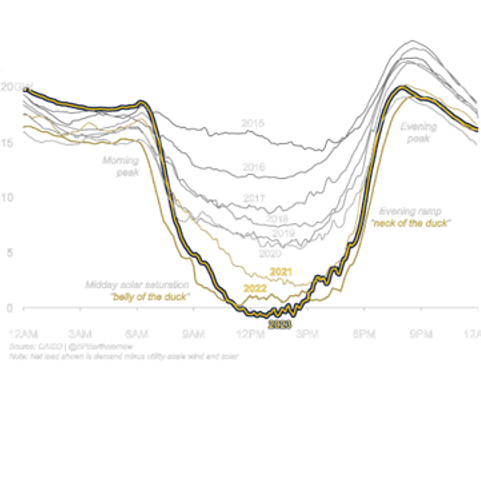Addressing the 'Duck Curve' dilemma: LDES leads the way
CONAN JONES, PRODUCT MANAGER
How we distribute and consume energy as a society is evolving, but we are still not yet ready for a carbon-free electric grid. In order to meet the demands of the grid effectively and efficiently, renewable sources, such as solar PV, should produce energy throughout the day, and store excess energy to address peak periods overnight. As the grid stands today, we are not there yet. As we look to make this a reality, it’s essential to understand what is needed and the challenges faced as demand on the energy grid increases.

The California Independent System Operator (CAISO) introduced the so-called duck curve concept in 2013 as a way to visualize the future of power production and consumption throughout the course of a day, showing the imbalance between peak demand and power generation envisioned with the further penetration of solar PV. The duck curve’s representation of the impacts on the grid is now top-of-mind in many discussions surrounding large-scale deployment of renewable energy systems, particularly solar PV. A more recent publication of the curve has shown that the actual situation over the proceeding years has been more drastic, already hitting ‘negative cost generation’ in 2023.
The Office of Energy & Renewable Energy explains the duck curve this way:
“The duck curve—named after its resemblance to a duck—shows the difference in electricity demand and the amount of available solar energy throughout the day. When the sun is shining, solar floods the market and then drops off as electricity demand peaks in the evening. The duck curve is a snapshot of a 24-hour period in California during springtime—when this effect is most extreme because it’s sunny but temperatures remain cool, so demand for electricity is low since people aren’t using electricity for air conditioning or heating.”
The official “duck chart” envisioned future impact of solar PV, first published by CAISO in 2013. Source: NREL/CAISO
There are three main parts of the “duck” which are important to consider:
1. The “belly of the duck”— Representing the increasing penetration of solar generation.
2. The “neck of the duck”— Representing evening ramp change.
3. The “head of the duck”— Representing evening peak load power demand.
As demand on the grid increases, the curve is becoming deeper, steeper, and higher across all three parts respectively - creating the equivalent of daily ‘pothole curves’ that impact energy networks’ roadmap to power supply and grid stability.
This blog will explain how we must appropriately address the duck curve to achieve a stable, carbon-free electric grid. We’ll also take a closer look at how long-duration energy storage (LDES) should be a part of the solution.
The urgent need for bulk energy shifting
There is an urgent need for greater bulk energy shifting in the power grid. As solar power production increases during the day, the surplus of generated electricity makes it easier to meet daily load demands. When this form of generation is no longer available and power demand increases in the evening, there is a severe imbalance between power needed vs. power available - representing the evening ramp or ‘neck of the duck’ which then needs to be provided by traditional ‘peaking’ generators, typically gas-fired. What once resembled a duck is now beginning to look like a canyon — sometimes called the canyon curve. Like the duck curve, this highlights the depth to which generation penetration drives the load-demand curve to have an increasingly deeper belly. This speaks to the urgent need for power to meet the evening ramp, and the need for bulk energy shifting to meet the electricity consumption needs for the overnight and morning hours when solar is not generating.
The deepening curve is proof that what we’re doing to support grid stability in a rapidly transitioning grid isn’t working fast enough. In May of 2023, California’s duck curve hit record lows, confirming the need for an energy storage-based solution capable of handling the increasing storage demands. Indeed, several regions in the U.S. and Australia have experienced events where excess generation must be curtailed or become associated with a cost to export to neighbouring regions and states and impacting the levels set for the supply security from other traditional generators.
The ideal energy storage solution
Adequate energy storage of varying durations is the first step to decreasing the disparities shown in today’s curve. If renewable energy is stored in abundance, with the necessary infrastructure to distribute electricity when needed throughout the night, we can decrease the strain in the grid networks currently brought on by renewable generation intermittency and the evening load-demand ramp and peak.
Energy storage resources enable us to draw power from daytime renewable energy production throughout the night, eventually extending sufficiently long enough to also help meet the morning peak demand. These solutions are moving us closer to 24/7 green energy generation and availability without relying on fossil-fuel generated power. But it’s important to recognize that the most appropriate energy storage technology should be applied at the right time of day and for the optimal discharge duration. Every solution has its place, and using the best one for each situation is key to ongoing success.
Traditional pumped hydro storage is a good long-term solution, but it requires massive capital investment, lengthy environmental and impact studies, and decades-long civil engineering implementation. And in many parts of the world, the vast majority of environmentally and economically acceptable locations for pumped hydro have already been exploited. However, various energy storage systems, including batteries such as lithium-ion and non-lithium long-duration flow batteries, are proven resources to meet the same need.
Lithium-ion battery storage: the ideal solution for short-duration and power-intensive demands
Lithium-ion batteries (LiBs) are currently fulfilling the power requirements for an approximately two-hour stationary discharge duration represented as the ramp-up, or ‘neck of the duck’, and are already addressing the short-duration and power-intensive stabilisation demands of the early evening peak.
However, LiBs are inapt to mop up all of the enormous amounts of excess solar generation during the day, which would otherwise be curtailed. Nor are they intended to dispatch the energy they have stored over longer durations of 8+ hours. Also, the demand for LiBs in EVs will only continue to constrain their availability for stationary storage applications and, therefore, further reduce their ability to meet the growing LDES demand, for which they are already inadequate.
Non-lithium flow battery storage: optimally suited for through-the-night loads
Non-lithium-based flow batteries, such as Redflow’s zinc-bromine flow battery (ZBFB), are well positioned to address the deepening duck curve situation. Redflow’s batteries have the unique capability of storing energy when available, and then entering a hibernation state with practically zero self-discharge, for many hours, days, or months at a time, and then being able to discharge that stored energy when needed.
This hibernation capability is ideally suited for applications where a reliable energy source is needed during emergencies where there is no other energy source – such as powering remote mobile phones and weather radar sites to deliver resilient essential communication and information services. It is also an ideal mechanism to raise the ‘belly of the duck’ by storing energy from daytime charging, hibernating for 4-8 hours, and then discharging to assist with reducing the evening peak load. Further, continuing to supply the through-the-night load as well as the morning peak for 10-14 hours until solar generation for the daytime loads can resume. Using the hibernation feature to schedule various overlapping optimal discharge rates and durations makes this completely achievable and avoids the self-discharge and parasitic load issues experienced by lithium-ion batteries sitting idle while waiting to discharge.
Additionally, with a degree of weather forecasting that is already prevalent in solar farm predictive generation planning, LDES-capable batteries could be charged and hibernated a few days ahead of any severe weather event or extended cloud-cover days. This will allow for the maintenance of dispatchable stored energy to address the daily peak load demand expectations, while still creating a degree of security of supply for essential services.
Flow batteries, such as Redflow’s, can significantly contribute to flattening the disparities in the net-load curve by:
- Charging as ‘dispatchable loads’ during the daytime peak solar generation – decreasing the depth of the curve.
- Supplying into the peak evening loads, reducing the magnitude of that peak demand.
- Flattening and lowering the through-the-night load curve.
- Reducing the impact of morning peak loads.
In conclusion, the continuing grid impacts as visualized through the duck curve, can be addressed using appropriate energy storage technologies and utilising the stored energy for differing durations and purposes throughout a 24-hour cycle. In the same way, as any country considers its overall energy generation mix, a combination of short- and long-duration storage technologies should be considered for the long-term stability of electricity supply to continue driving grid stability and resilience.

+ 61 7 3376 0008
[email protected]
Hey there, this is the default text for a new paragraph. Feel free to edit this paragraph by clicking on the yellow edit icon. After you are done just click on the yellow checkmark button on the top right. Have Fun!